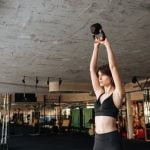Fitness models are often admired for their toned physiques and sculpted muscles, serving as inspiration for many individuals embarking on their fitness journeys. But behind the glamorous photoshoots and magazine covers lies a world of hard work, dedication, and specialized training. The question that often arises is: do fitness models workout differently to achieve their enviable bodies?
To truly understand the realm of fitness models, one must delve into the intricacies of their workout routines, diet plans, and training techniques. These individuals go beyond simply hitting the gym; they meticulously curate every aspect of their fitness regimen to ensure that they are always in top form. From intense workouts to strict nutrition guidelines, fitness models follow a disciplined approach to maintain their physique.
While many may assume that fitness models simply have good genetics or spend hours in the gym, the reality is that their workout routines are carefully crafted to target specific muscle groups and achieve a balanced physique. Through a combination of strength training, cardio exercises, and unique training techniques, fitness models work towards sculpting their bodies in a way that sets them apart from the average gym-goer.
The Importance of Workout Routines for Fitness Models
Fitness models are often admired for their sculpted physiques and toned bodies, but achieving and maintaining such a look requires dedication to a well-structured workout routine. The importance of workout routines for fitness models cannot be understated, as these individuals rely on their physical appearance as part of their career. While many may wonder if fitness models workout differently from the average gym-goer, the truth lies in the level of commitment and specificity in their training.
One key aspect of a fitness model’s workout routine is consistency. These individuals typically adhere to a strict schedule that includes regular workouts targeting different muscle groups. This consistency not only helps them achieve their desired physique but also allows them to track progress and make necessary adjustments to their training regimen. Additionally, variety plays a crucial role in keeping workouts challenging and engaging for fitness models, preventing plateaus and promoting continuous improvement.
In addition to consistency and variety, intensity is another important factor in a fitness model’s workout routine. High-intensity training techniques, such as circuit training, HIIT (high-intensity interval training), or heavy lifting, are commonly incorporated into their workouts to maximize results in a shorter amount of time.
This level of intensity not only boosts metabolism and burns more calories during the workout but also leads to greater muscle definition and overall strength gains over time. By pushing their limits consistently, fitness models are able to achieve and maintain the physique that is expected in their industry.
| Factor | Importance |
|---|---|
| Consistency | Key for progress tracking and regimen adjustment |
| Variety | Prevents plateaus and promotes continuous improvement |
| Intensity | Maximizes results in shorter time span |
Do Fitness Models Follow a Specific Diet Plan?
Fitness models are known for their toned physiques and sculpted bodies, but achieving such a look requires more than just hitting the gym regularly. A crucial component of a fitness model’s success lies in their diet plan. These individuals generally follow strict nutrition guidelines to help them achieve their desired physique and maintain it year-round.
Here are some key elements commonly found in a fitness model’s diet plan:
- High Protein Intake: Protein is essential for muscle repair and growth, which is why fitness models typically consume a high amount of protein-rich foods such as chicken, fish, eggs, and plant-based sources like tofu or legumes.
- Complex Carbohydrates: Carbs are not the enemy for fitness models; they need sufficient energy for their intense workout routines. However, they often opt for complex carbohydrates like quinoa, sweet potatoes, and brown rice to sustain their energy levels throughout the day.
- Healthy Fats: Despite popular belief, fats are crucial for overall health and hormone regulation. Fitness models include sources of healthy fats like avocados, nuts, seeds, and olive oil in their diet to support their training performance.
In addition to these basic principles, fitness models often track their calorie intake to ensure they are in a caloric deficit to promote fat loss while preserving muscle mass. Many may also strategically time their meals around workouts to optimize performance and recovery. It is important to note that individual diet plans may vary depending on specific goals and body type.
Considering the demanding nature of being a fitness model, the question remains: do fitness models workout differently compared to regular gym-goers? The answer lies not only in the exercises they perform but also in the intensity of their training sessions and the strategic way they structure their workouts. While both groups may engage in similar movements like squats or deadlifts, fitness models often incorporate specific training techniques unique to their profession.
Some common training techniques that set apart fitness models’ workouts include:
- Circuit Training: Fitness models frequently utilize circuit-style workouts that combine strength training exercises with minimal rest periods between sets. This approach not only enhances calorie burn during the session but also promotes cardiovascular endurance.
- Supersets: To maximize muscle engagement and time efficiency during workouts, many fitness models incorporate supersets into their routines. By pairing two exercises back-to-back targeting different muscle groups or the same group from different angles, they can effectively challenge themselves while saving time.
- Plyometric Training: Adding explosive movements like box jumps or burpees helps improve power output and agility for fitness models who may be required to participate in photo shoots or events that demand dynamic movement.
Overall, while there may be similarities between a regular gym-goer’s workout routine and that of a fitness model, it is the intensity and specificity of exercises that truly distinguish how these individuals train. These unique training techniques play a pivotal role in helping fitness models achieve and maintain their enviable physiques.
Training Techniques Unique to Fitness Models
Fitness models may have a glamorous image, but behind the scenes, they put in a lot of hard work and dedication to achieve their toned physique. One aspect that sets them apart is their unique training techniques that focus on sculpting muscles and achieving a lean, defined look. Here are some key training techniques that fitness models often incorporate into their workout routine:
- Circuit Training: Fitness models often engage in circuit training to maximize calorie burn and muscle engagement. This involves performing a series of exercises back-to-back with minimal rest in between sets.
- High-Intensity Interval Training (HIIT): HIIT workouts are popular among fitness models for their ability to torch fat and improve cardiovascular endurance in a short amount of time. These workouts typically alternate between intense bursts of exercise and brief periods of rest.
- Compound Movements: Compound exercises like squats, deadlifts, and bench presses are staples in many fitness models’ routines as they target multiple muscle groups simultaneously, allowing for efficient strength gains and calorie burn.
By incorporating these training techniques into their workout regimen, fitness models can not only achieve a sculpted physique but also enhance their overall athletic performance. While these workouts may be challenging, they are essential for maintaining the aesthetic appeal required in the competitive world of fitness modeling.
In addition to these training techniques, consistency is key for fitness models when it comes to working out. They often adhere to strict workout schedules and make sure to push themselves during each session.
This level of dedication helps them stay on track towards their fitness goals and maintain the physique that is expected of them in the industry. Ultimately, while the workouts may differ slightly from those of regular gym-goers, the commitment and effort put into each session are what truly sets fitness models apart.
Differences Between a Regular Gym-Goer and a Fitness Model’s Workout
Fitness models are known for their toned bodies, sculpted muscles, and overall physical fitness. Many people often wonder if fitness models workout differently than the average gym-goer. The truth is, while both groups engage in exercise to stay fit, there are noticeable differences in their workout routines and approaches.
Focus on Specific Muscle Groups
One key difference between a regular gym-goer and a fitness model’s workout is the focus on specific muscle groups. Fitness models often target specific areas of their body that need improvement or that they want to showcase during photo shoots or competitions. This targeted approach helps them achieve a well-balanced and aesthetically pleasing physique.
High Intensity Training
Fitness models also tend to incorporate high-intensity training techniques into their workouts. This type of training involves short bursts of intense exercises followed by brief periods of rest or lower intensity activity. High-intensity training can help improve cardiovascular health, increase muscle strength, and burn more calories in a shorter amount of time – all important factors for fitness models looking to maintain their physique.
Variety in Workouts
Another distinguishing factor in a fitness model’s workout routine is the variety of exercises they perform. While regular gym-goers may stick to familiar routines and exercises, fitness models often switch up their workouts to challenge different muscle groups, prevent boredom, and continue seeing progress.
This variety can include anything from weightlifting and resistance training to yoga, pilates, and even dance cardio sessions. By keeping their workouts diverse, fitness models can sculpt their bodies in unique ways that set them apart from the average gym enthusiast.
How Do Fitness Models Maintain Their Physique Year-Round?
Fitness models are known for their impeccable physique that seems to be maintained year-round. Many people wonder how they manage to stay in top shape consistently. One key aspect of how fitness models maintain their physique is through dedication and discipline in their workout routines. Unlike the average gym-goer who may take breaks or have cheat days, fitness models adhere strictly to their exercise regimens. Consistency is essential for them to stay photo-ready at all times.
Another crucial factor in how fitness models maintain their physique year-round is by incorporating variety into their workouts. They often switch up their exercises, intensity levels, and training techniques to prevent plateaus and keep challenging their bodies.
This keeps their muscles engaged and continuously adapting, leading to ongoing progress in terms of muscle tone and definition. By constantly challenging themselves with new workouts, fitness models can continue to sculpt their bodies and achieve the desired look for photoshoots and events.
Additionally, nutrition plays a significant role in how fitness models maintain their physique throughout the year. They follow strict diet plans tailored to meet their fitness goals while also providing the necessary nutrients for peak performance during workouts.
By fueling their bodies with the right balance of macronutrients, they can maximize their training results and support muscle growth and recovery. Overall, a combination of consistent workout routines, varied training techniques, and a disciplined approach to nutrition allows fitness models to maintain their enviable physiques year-round.
The Role of Supplements in the Fitness Modeling Industry
The fitness modeling industry is no stranger to the use of supplements to enhance performance, aid recovery, and achieve optimal results. Fitness models often have demanding workout schedules and rigorous training routines that require additional support to maintain their physique. While supplements are not a substitute for a healthy diet and exercise regimen, they can play a significant role in helping fitness models meet their goals.
Protein supplements are particularly popular among fitness models as they help to promote muscle growth and repair. Many fitness models incorporate protein shakes or bars into their daily routine to ensure they are getting an adequate amount of protein to support their intense workouts. Additionally, some fitness models may also use other types of supplements such as branched-chain amino acids (BCAAs) to further support muscle recovery and reduce muscle soreness.
Another common supplement used by fitness models is creatine, which is known for its ability to increase strength, power, and muscle mass. By incorporating creatine into their supplementation regimen, fitness models may experience improvements in their performance during workouts, ultimately leading to better results. It is important for fitness models to consult with a healthcare provider or nutritionist before incorporating any new supplements into their routine to ensure they are safe and effective for their individual needs.
| Supplement | Role |
|---|---|
| Protein | Promotes muscle growth and repair |
| BCAAs | Supports muscle recovery and reduces soreness |
Balancing Cardio and Strength Training for Optimum Results
Fitness models are known for their toned and sculpted physiques, which often leave many wondering: do fitness models workout differently to achieve such impressive results? One key aspect that sets fitness models apart is their ability to balance cardio and strength training effectively. This strategic combination plays a crucial role in helping them achieve their desired physique and overall fitness goals.
The Importance of Cardio
Cardiovascular exercises, such as running, cycling, or swimming, are essential for fitness models to maintain low levels of body fat while increasing stamina and endurance. Incorporating regular cardio sessions into their workout routines helps them burn calories efficiently and improve cardiovascular health. By engaging in high-intensity interval training (HIIT) or steady-state cardio workouts, fitness models can enhance fat loss without sacrificing muscle mass.
The Significance of Strength Training
On the other hand, strength training is vital for building lean muscle mass, defining muscles, and boosting metabolism. Fitness models often focus on resistance exercises like weightlifting to sculpt their bodies and create that desirable “toned” look. By incorporating compound movements such as squats, deadlifts, and bench presses into their routines, they target multiple muscle groups simultaneously and promote overall strength development. Additionally, strength training helps prevent muscle loss during periods of calorie restriction or intense cardio sessions.
Finding the Right Balance
To achieve optimal results, fitness models must strike a balance between cardio and strength training in their workout regimen. This balance varies depending on individual goals, body composition, and competition preparation timeline.
Some may prioritize more cardio leading up to an event to reduce body fat percentage quickly, while others might focus on increasing strength through resistance training during off-season periods. Ultimately, finding the right blend of both cardio and strength exercises is key to achieving a well-rounded physique that stands out in the competitive world of fitness modeling.
Conclusion
In conclusion, the world of fitness modeling is often shrouded in mystery and misconceptions. While there are certainly some unique aspects to the workout routines of fitness models, it is important to debunk the myth that they follow drastically different regimens than regular gym-goers. The truth is that at the core, fitness models focus on consistency, dedication, and hard work just like anyone else striving for their fitness goals.
One common question posed is whether fitness models workout differently than the average person. The answer lies in the fact that while they may incorporate specific training techniques tailored to their physique goals, the foundation of their workouts often includes a mix of strength training, cardio, and flexibility exercises – principles that are universal in achieving overall health and fitness.
What sets them apart is perhaps the level of commitment and discipline they bring to their routines, as well as sometimes working with personal trainers or coaches who can help optimize their results.
Ultimately, understanding the world of fitness modeling sheds light on the importance of balance in both diet and exercise for achieving and maintaining a fit physique year-round. While supplements may play a role in enhancing performance for some fitness models, they should not be seen as a shortcut to success.
By focusing on consistent effort in both their workouts and nutrition plans, fitness models showcase that it is not about working out differently but about working out smarter and with purpose towards their ultimate goals.
Frequently Asked Questions
How Do Fitness Models Workout?
Fitness models typically engage in a combination of strength training, cardio, and flexibility exercises to stay in shape. Their workouts are often intense and varied to target different muscle groups and keep their bodies challenged.
How Many Hours a Week Do Fitness Models Workout?
Fitness models usually work out anywhere from 5 to 6 days a week, dedicating around 1-2 hours per session. This consistent routine helps them maintain their physique while allowing enough time for rest and recovery.
How Do Fitness Models Get So Lean?
To achieve the lean look that fitness models are known for, they pay close attention to both their diet and exercise regimen. They focus on high-protein, low-carb meals to support muscle growth and fat loss while incorporating HIIT (High-Intensity Interval Training) cardio sessions to boost their metabolism and burn calories efficiently.
Additionally, they often incorporate strength training exercises to build muscle mass and increase their overall calorie-burning potential.

Passionate about providing useful information to anyone with an interest in the field of Personal Training, I strive to pass on to our readers quality information and to answer any questions about Personal Trainers, the work they do and how to become one.





